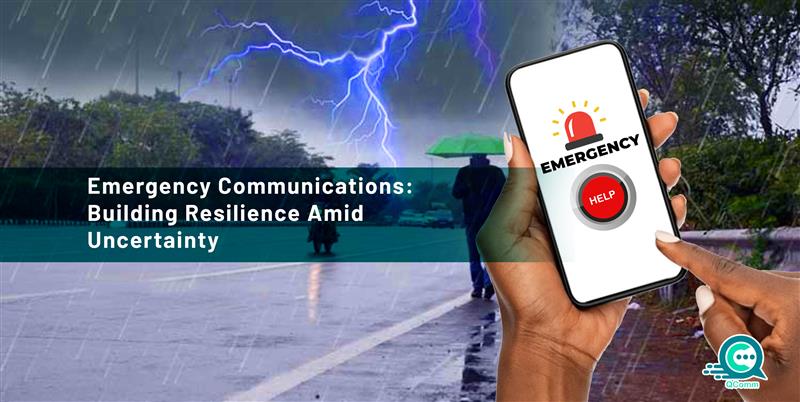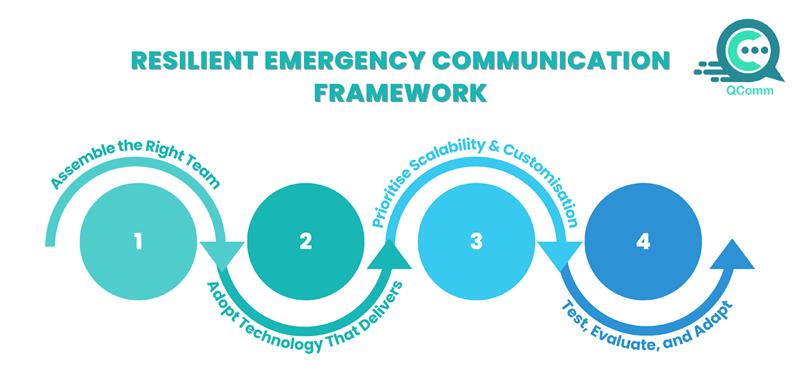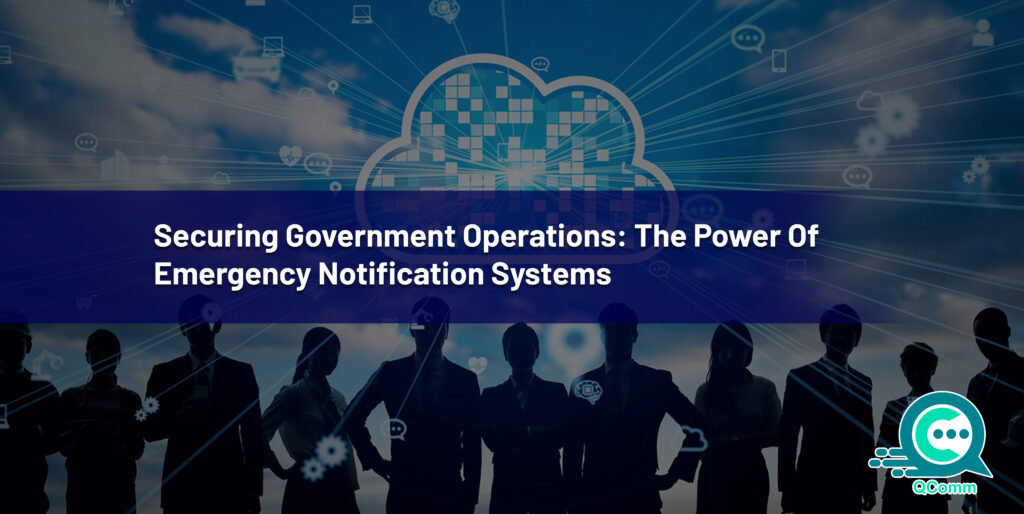
What if everything stopped in an instant? A server fails, operations freeze, and teams are left stranded without direction. Compare this to an organization where protocols snap into place—alerts fire off, backup systems activate, and workflows resume almost seamlessly. critical server crashes, paralyzing operations. Teams are left scrambling, decisions stall, and confusion takes hold. Meanwhile, another company facing the same issue executes a structured response plan: notifications are sent, backups kick in, and disruptions are minimized. Crash brings operations to a halt. Employees scramble, unsure of what to do. Minutes feel like hours. Meanwhile, in another company facing the same issue, a swift alert is sent out, backup systems are activated, and operations continue seamlessly.
What makes the difference? Communication.
Emergencies don’t announce their arrival, but a well-prepared organization can meet any crisis with clarity and confidence. By prioritizing seamless information flow and real-time updates, organizations can ensure they remain connected, informed, and resilient—no matter the challenge.
Here’s how effective emergency communications can transform uncertainty into decisive action.
What Sets Effective Emergency Communication Apart?
Emergencies can arise from various unpredictable sources, both external and internal, posing significant threats to an organization’s operations, safety, and reputation. Understanding these threats and having a comprehensive response plan is essential for maintaining stability during crisis situations. While external emergencies often stem from uncontrollable factors, internal threats tend to emerge from within the organization’s systems and workforce, requiring swift, decisive action to minimize impact.
Key Principles of Emergency Communication:
- Natural Disasters: Events like earthquakes, cyclones, and floods can severely impact infrastructure, disrupt transportation, and threaten public safety, leading to operational delays.
- Public Health Crises: Outbreaks of diseases, such as pandemics or regional epidemics, can strain the workforce and shift priorities to health protocols, including remote work and safety measures.
- Community Disruptions: Protests, large-scale accidents, and power outages can disrupt access to essential facilities and resources, halting daily operations.
- Severe Weather Conditions: Extreme heat waves, monsoons, and heavy rainfall can impede travel, damage infrastructure, and delay critical business activities.
The Key Focus is to ensure the rapid flow of accurate information is vital to effective decision-making and minimizing disruptions during emergencies.
Internal Emergencies:
- Cybersecurity Incidents: Ransomware attacks, data breaches, or hacking attempts can compromise sensitive data, disrupt operations, and harm an organization’s reputation.
- Technological Failures: Issues such as system downtimes, server crashes, or data center outages can cripple operations, emphasizing the importance of robust backup systems and recovery plans.
- Human Resource Crises: Workplace violence, employee misconduct, or whistleblower incidents require immediate, sensitive, and well-managed responses to maintain workplace safety and morale.
- System Maintenance Issues: Poorly managed or unplanned downtime during system maintenance can disrupt operations and create unnecessary delays.
The Key Focus is clear and concise communication is critical to addressing internal emergencies swiftly and ensuring a smooth recovery, which is essential for organizational resilience.
What Sets Emergency Communications Apart
Unlike traditional crisis management, which often focuses on containment and resolution, emergency communications prioritize information centralization and real-time responsiveness. This approach ensures that every stakeholder, employees, clients, partners, and community members remains informed and empowered.
The Key Principles of Emergency Communications
- Proactive Planning
Emergencies are unpredictable, but responses shouldn’t be. Establishing protocols, conducting drills, and leveraging scenario-based simulations can prepare teams for any eventuality. - Centralized Information Hubs Disjointed or scattered information creates confusion during critical situations. A centralized platform that integrates alerts, updates, and action plans allows for quicker decision-making and coordinated responses.
- Real-Time Connectivity Emergencies evolve rapidly. A robust communication system ensures that updates are instantaneous, minimizing delays and ensuring that decisions are based on the latest data.
- Inclusivity and Accessibility Emergency communication should reach everyone, regardless of location, language, or device. Whether employees are on-site, remote, or traveling, critical updates must be accessible to all stakeholders seamlessly.
Building a Resilient Emergency Communication Framework
A resilient framework involves much more than reactive messaging. It integrates technology, people, and processes into a cohesive strategy that ensures swift and effective response during a crisis. This framework helps organizations stay prepared and responsive, minimizing the impact of emergencies on operations, employees, and stakeholders. The flowchart below outlines the essential steps in building such a framework, focusing on the importance of assembling the right team, adopting technology that ensures speed and precision, prioritizing scalability and customization, and continuously testing and adapting the communication strategy to meet evolving challenges.

The Role of Communication in Specific Emergency Scenarios
1. Natural Disasters
When the forces of nature strike, communication becomes a lifeline. Real-time weather alerts, evacuation instructions, and safety check-ins can significantly reduce the risk to life and property.
2. Cybersecurity Breaches
During a data breach, transparency is critical. Immediate notifications to IT teams, legal departments, and affected parties can mitigate damage and rebuild trust.
3. Workplace Disruptions
From technical outages to unexpected workplace closures, internal communications must address employee concerns while maintaining business continuity.
4. Reputational Crisis
In the age of social media, news spreads fast. A carefully crafted external communication strategy can protect brand reputation and ensure that the organization remains in control of the narrative.
Emergency Communications: Strengthening Connections When It Matters Most
Emergencies don’t wait and neither should your communication. Whether it’s a natural disaster, cybersecurity breach, or internal disruption, the ability to coordinate and connect quickly across all levels of an organization can make the difference between chaos and control.
Why QComm Makes a Difference:
- Seamless Multi-Device Connectivity: Ensure that critical updates reach everyone, regardless of whether they’re using a phone, tablet, or desktop.
- Clear and Accessible Alerts: From leadership to frontline employees, QComm ensures that messages are clear, concise, and actionable, minimizing confusion during critical moments.
- Centralized Response Management: Integrate alerts, instructions, and updates into a single platform, so decision-making is swift and organized.
- Customizable Frameworks: Adapt protocols to suit your organization’s unique needs, ensuring preparedness for every kind of emergency.
These features aren’t just about technology, they’re about empowering people. QComm bridges gaps in communication and simplifies emergency responses, so your team can focus on what truly matters: safety, continuity, and recovery.
Building Resilience, One Step at a Time
Preparedness isn’t about eliminating uncertainty, it’s about being ready for it. Organizations that invest in robust communication systems like QComm show a commitment to their people and operations. By fostering trust, reducing downtime, and enabling quick action, they don’t just survive crises—they grow stronger through them.
Your Next Step: Be Prepared
When seconds matter, clarity and coordination are essential. Equip your organization with a communication system designed to keep everyone connected and well informed. Visit QComm today to discover how you can build resilience, simplify crisis management, and face the unexpected with confidence.


